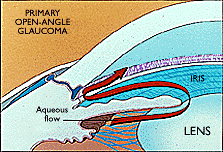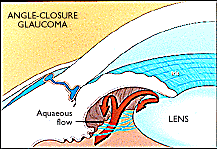| Glaucoma Home Types |
Types of GlaucomaThe most common form of glaucoma is open-angle glaucoma. In open-angle glaucoma, the aqueous, or fluid, that normally flows through the pupil into the anterior chamber (the front section of the eye's interior) cannot get through the trabecular meshwork (the eye's filtration area) to the normal drainage canals. This causes a buildup of pressure in the eye (intraocular pressure, or IOP), which can damage the optic nerve and lead to vision loss.
Most people who develop open-angle glaucoma notice no symptoms until vision is impaired.
In acute angle-closure glaucoma there is a sudden increase in intraocular pressure (IOP) due to the buildup of aqueous in the eye. Acute angle-closure glaucoma is considered an emergency because optic nerve damage and subsequent vision loss can occur within hours of the onset of the problem. Symptoms of this kind of glaucoma can include nausea and vomiting, seeing haloes around light, and pain in the eye. Chronic angle-closure glaucoma, like open-angle glaucoma, may cause vision damage without symptoms. Although angle-closure glaucoma is unusual, people of Asian or Eskimo ancestry are at higher risk of developing it. As with other forms of glaucoma, age and family history are also risk factors, and the problem seems to occur in older women more often than others. Both open-angle and angle-closure glaucoma can be primary or secondary. A primary condition is one that cannot be attributed to any known cause. A secondary condition can be traced to another cause, such as previous injury or illness. "Normal (or low) tension" glaucoma is an unusual and poorly understood form of the disease. In this type of glaucoma, the optic nerve is damaged even though the patient's intraocular pressure is consistently within a range usually considered normal. Childhood glaucoma is rare, and starts in infancy, childhood or adolescence. Like open-angle glaucoma, there are few, if any, symptoms in the early stage, and blindness can result if it is left untreated. Like most types of glaucoma, this type of glaucoma is thought to have a hereditary component. Congenital glaucoma is a type of childhood glaucoma that usually appears soon after birth, although it can become apparent later in the first year of life. Unlike other childhood glaucomas, congenital glaucoma often has noticeable signs, including tearing, light sensitivity, and cloudiness of the cornea. This type of glaucoma is more common in boys, and can affect one or both eyes. Your ophthalmologist may tell you that you're a glaucoma suspect if you have one or more risk factors for glaucoma. These may include elevated intraocular pressure (IOP), family history, ethnic background, older age, optic nerve appearance, and other factors. Elevated IOP is sometimes called ocular hypertension. This means that your IOP is higher than what is considered "normal." A diagnosis of ocular hypertension does not mean you have glaucoma, but it does mean you're at increased risk, and should probably have frequent medical eye examinations. Sometimes your ophthalmologist will recommend medication to lower your IOP. Treatment for glaucoma may include medicaion and/or surgery. If you think you're at risk for glaucoma, and haven't had a medical eye examination in the past two years, you can call the Eye Room at Manila Doctors Hospital 524-3011 loc 3720 for a referral to an ophthalmologist in your area.
|


